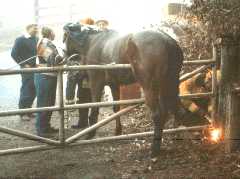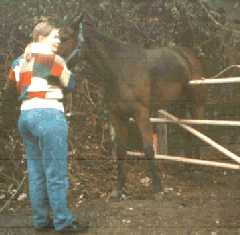LARGE ANIMAL RESCUE SKULL SESSION
|
| JUMPER THAT DIDN'T QUITE JUMP |
|
This problem is based on a real scenario and is presented for a "Skull Session" discussion in the Technical Large Animal Emergency Rescue Facebook Group.
A number of excellent comments were posted to the group. Here is a recap of the incident as presented, followed by group feedback and the actual details of how the rescue was achieved. Location The incident has occurred in the suburban edge of a metropolitan area alongside a relatively busy secondary commute surface road. Date and Time About 7:30 AM on a commute weekday in the morning fog. Incident Details You receive a call from Animal Services to assist with a thoroughbred horse that for some reason spooked and tried to jump the entrance gate where she was stabled. Given the proximity of the road, the horse fortunately didn't clear the gate but is now stuck with her hind legs unable to quite reach the ground. The gate is welded and cannot simply be unbolted. Equipment on-scene includes a dog catcher and highway patrol officer. Equipment enroute includes the local fire department's rescue unit. Upon arrival you see the horse hung up on the gate, hind legs dangling, with her owner at her head keeping her calm.
The scene on your arrival.
|
| ACTUAL RESCUE ACTIVITIES |
Upon arrival the owner, an Animal Control Officer and a CHP officer were present. A veterinarian was enroute.
The horse was calm. Her hind legs were hanging against the gate. We opted not to try to build up the ground in this incident as there was no loose dirt handy (just mud in the drizzling fog) plus we didn't want her to get a leg through the lower rail.
The owner had a calming effect on the horse and thus she was allowed to continue holding and calming the horse.
The gate had welded hinges so it couldn't be simply unbolted.
I called for the rescue cutting torch and our best on-duty torch operator.
We located a saddle blanket to shield the horse's head on the cutting torch side. We had the horse's owner stand on the side away from the cutting operation.
Setting up to remove the gate hinges

We cut the bottom hinge first.
Cutting with the acetylene torch

(Note: There was not room to slide the gate out from under the horse due to the position of the gate posts but she walked over the laid-down gate just fine.)
The veterinarian then provided a follow-up examination and determined that aside from some abrasions, the horse suffered no significant injuries.
Go to Skull Session Index
Return to the Strike Team LRTC Page
This material is intended for the use of the Technical Large Animal Emergency Rescue (TLAER) Facebook Group. TLAER is a trademark of Technical Large Animal Emergency Rescue. |
